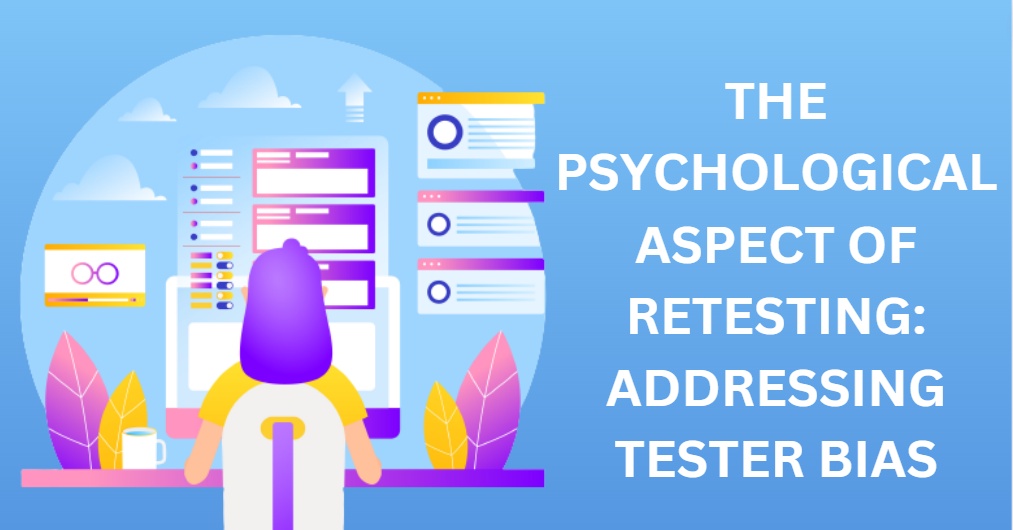Understanding Tester Bias in Retesting
Tester bias is defined as systemic mistakes or aberrations in judgment and taking decisions generated by testers inadvertently throughout the software testing process, specifically retesting. These prejudices can have an impact on the impartiality and precision of test findings, perhaps resulting in missed faults or false positives/negatives. Recognizing and dealing with tester bias is critical for preserving the testing process's credibility and delivering trustworthy software quality evaluations.
Key Factors Contributing to Tester Bias:
1. Prior Knowledge and Experience: Testers may carry over their previous experiences with the software or similar projects, leading to assumptions about its behavior and functionality.
2. Confirmation Bias: Testers might unconsciously seek evidence that confirms their initial beliefs about the software's quality while overlooking or downplaying contradictory information.
3. Anchoring Bias: The first piece of information testers encounter about the software, such as initial positive impressions, can influence subsequent evaluations and prevent testers from reassessing their judgments.
4. Time Constraints: When under pressure to complete testing within tight deadlines, testers may rush through retesting and overlook potential defects or issues.
5. Emotional Attachment: Testers who were involved in the development process or have a personal attachment to the software may inadvertently downplay its shortcomings.
6. Availability Bias: Testers may give undue importance to defects that are easy to remember or recently encountered, potentially ignoring less memorable but equally critical issues.
7. Social Bias: The influence of team dynamics or pressure to conform to the opinions of colleagues can affect individual judgments during retesting.
Types of Tester Bias
Types of Tester Bias in Software Testing:
Tester bias in software testing refers to the subconscious influences that can skew a tester's judgement and evaluation of a software product. Several types of bias can affect the objectivity of testing outcomes:
1. Confirmation Bias: Testers tend to search for information that confirms their initial beliefs about the software's quality while ignoring contradictory evidence.
2. Anchoring Bias: The first piece of information a tester encounters can dilute their subsequent judgments, preventing them from fully reassessing their evaluation.
3. Availability Bias: Testers give more weight to defects or scenarios that readily come to mind, leading to an imbalance in defect identification.
4. Observer Bias: Testers' expectations influence their observations, potentially leading to selective attention to certain aspects of the software.
5. Experimenter Effect: Testers' presence or involvement influences the software's behavior, impacting their perception of its quality.
6. Cultural Bias: Personal cultural backgrounds can lead testers to prioritize certain features or aspects based on their own cultural context.
7. Groupthink: The desire for consensus within a testing team can suppress contradictory opinions, hindering thorough evaluation.
8. Self-Serving Bias: Testers attribute successful outcomes to their skills but attribute failures to external factors, affecting their analysis.
The Halo Effect
The Halo Effect, an unconscious prejudice, can have a considerable influence on retesting results. It happens when a tester's first favorable opinion of the software application impacts their entire judgment, perhaps leading to the overlooking of errors or flaws. This bias stems from the way people think; if a tester considers a certain feature of the program remarkable, they may unintentionally extrapolate that enthusiasm to other parts, concluding that the product as a whole is of excellent workmanship. The Halo Effect can inhibit testers from rigorously revising software in retesting circumstances, ultimately causing inadequate fault discovery. To counteract the Halo Effect, testers should approach testing again with a willingness to reconsider, putting earlier opinions aside and assessing the program with as much impartiality as possible. Structured test scenarios and clear criteria can help to reduce the impact of this bias. Involving several testers in the cross-validation procedure can also give varied viewpoints, aiding in the elimination of personal preconceived notions and producing more credible retesting findings.
Continuous Learning and Bias Awareness for Testers:
1. Bias Awareness Training: Providing testers with training on various types of biases and their potential impact on testing can help them recognize and acknowledge their own biases. This awareness encourages testers to approach retesting with an open mindset.
2. Regular Skill Enhancement: Keeping testers up-to-date with the latest testing methodologies, tools, and industry trends can improve their skills. A well-informed tester is more likely to approach retesting systematically, reducing the influence of personal bias.
3. Sharing Testing Experiences: Encouraging testers to share their testing experiences and challenges with peers fosters a collaborative environment. By discussing instances where biases might have influenced their evaluations, testers can collectively learn and grow.
4. Peer Reviews and Feedback: Implementing peer reviews and feedback mechanisms for retesting results promotes accountability. Testers can identify biases in each other's work, leading to more balanced and accurate assessments.


No comments yet